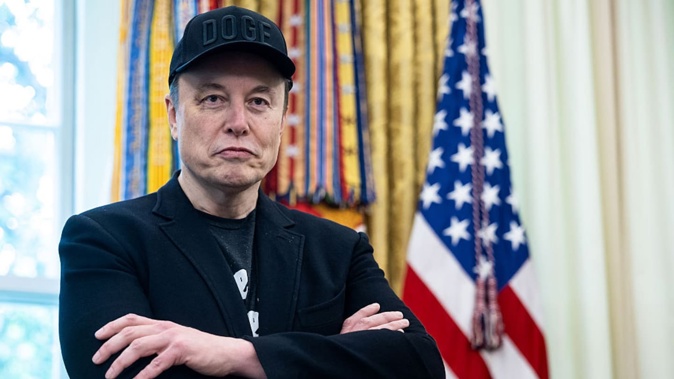
The richest man in the world says he has started a new United States political party, which he says will represent “the 80%” of voters “in the middle”.
Tesla chief executive Elon Musk last year went all-in on using his wealth to support Republican Donald Trump’s successful 2024 run for president, cementing him as the country’s largest political donor.
He later led the formation of the Trump Administration’s US Doge Service in an effort to cut the size of government.
However, Musk, who also leads SpaceX and owns the social platform X, appears to be done with supporting Trump and most Republicans in Congress.
Motivated by what he has suggested is his disdain for high government spending, Musk vowed to create “the America Party” if Congress approved the massive tax policy and spending bill backed by the President.
At the weekend, after Trump signed the bill into law, Musk said on X that the party had officially been “formed to give you back your freedom”.
Musk’s party faces major challenges, ranging from a political structure that favours the two-party system to his personal temperament. Here’s a look at some of the biggest obstacles.
1 Institutional barriers and ballot rules
America’s winner-take-all electoral system is not welcoming to third parties.
Hans Noel, a professor who teaches political history and political methodology at Georgetown University, said the US does not have “institutions that are open to multi, third parties being super successful”.
“You have to win outright in order to get anything,” Noel said.
“So it’s not like in other democracies where you start a small party and you get, you know, 20 or 30% of the vote, and then you get some share of the seats in the legislature and you can build from that.”
Beyond the winner-take-all system, if Musk wants to buoy federal candidates in different states or, eventually, establish a third-party presidential candidate, his new organisation will have to comply with the varying requirements for getting on ballots.
States and the Federal Election Commission have rules and requirements for registering a new political party. States also have their own rules, often including residential requirements and petition signatures from voters.
Mac McCorkle, a professor at the Sanford School of Public Policy at Duke University, said the ballot criteria could pose a “daunting” problem.
“To get on the ballot, there’s going to be a lot of petition signature requirements,” said McCorkle, who previously worked as a Democratic consultant. “On the other hand, he probably has enough money to be able to do that.”
These requirements have tripped up many third-party candidates.
During the 2024 presidential election, no notable third-party candidates, including the Libertarian Party’s Chase Oliver, the Green Party’s Jill Stein, Cornel West and Robert F. Kennedy jnr, appeared on ballots in all 50 states.
2 Historical headwinds and recent challenges
Political parties outside the American two-party system have long existed, but their recent national appeal has been limited.
The last time a presidential candidate who was not a Republican or Democrat won electoral votes was 1968, when five Southern states went for American Independent Party nominee George Wallace.
Billionaire tycoon Ross Perot received about 19% of the popular vote in 1992 and no Electoral College votes.
“Perot did amazingly well … but he didn’t come in first in any state, and the way the Electoral College works, that means he’s got nothing,” Noel said.
Ralph Nader’s 2000 run for president under the Green Party, experts have argued, contributed to such a close outcome in Florida that Republican George W. Bush won the election only after the Supreme Court weighed in. Still, Nader obtained zero electoral votes.
Independent senators Bernie Sanders (Vermont) and Angus King (Maine), caucus with Democrats.
Two former senators who left the Democratic Party and became independents while still in office, Kyrsten Sinema of Arizona and Joe Manchin of West Virginia, did not run for re-election in 2024.
Justin Amash represented Michigan in the House of Representatives, starting as a Republican but leaving the party in 2019 and becoming a Libertarian in 2020. After considering a Libertarian presidential run, he decided not to seek re-election to his House seat.
3 Scope and strategy
Musk wrote on X that he plans to target the Midterm elections next year.
He likened his strategy to the tactics of Greek general Epaminondas against the Spartans: “Extremely concentrated force at a precise location on the battlefield”.
Musk previously mused about the potential to influence the make-up of Congress by focusing on a small number of key Senate and House races, but he has not named specific targets.
“Given the razor-thin legislative margins, that would be enough to serve as the deciding vote on contentious laws, ensuring that they serve the true will of the people,” Musk wrote on X.
Although McCorkle believes Musk’s candidates won’t win, the Duke professor said they can act as “spoilers and confusers” undermining Republicans running for office and capturing just enough votes to make a difference in battleground states like North Carolina.
Musk’s nominees could affect Midterm elections, when there’s “probably going to be a drop-off of Maga voters,” McCorkle said.
Musk opposes the tax-and-spending measure passed by Republicans and signed into law by Trump this week.
A plurality of Americans also oppose it, according to a Washington Post-Ipsos poll conducted last month. A 63% majority of the public in the poll said that the spending package’s estimated US$3 trillion ($5t) increase to the national debt is unacceptable.
McCorkle contended that the billionaire’s opposition to the spending does not yet constitute a long-term party strategy, and that the massive federal contracts secured by the companies he runs could undermine his message.
“Here’s the guy who has got more government contracts than anybody can imagine, and he’s going to be the standard-bearer for libertarians? I don’t know.”
4 Divisions among his potential audience
Musk appeared to agree with an X user who laid out a party platform that calls for: reducing the national debt; modernising the military with artificial intelligence and robotics; supporting deregulation and free speech; backing “pro tech” and pronatalist stances; and supporting “centrist policies everywhere else”.
However, the 80% of “the middle” that Musk says he is after, Georgetown’s Noel argued, does not necessarily have enough cohesion to form a political party.
“People have attachments to the existing parties, and they’re frustrated with them, and they don’t like them.
“People have concerns, but there’s no sort of constituency that he’s got,” Noel said. “What is he going after? … That 80% is not well defined at all.”
5 Garnering political allies
In the wake of his exit from the federal government and his subsequent blow-up with Trump and congressional Republicans, Musk’s influence with the party appears to be waning.
Trump ally James Fishback has already said that he’s establishing a super PAC to blunt Musk’s political efforts.
While Musk’s wealth has served his political efforts, strong political parties can raise money from networks of interested voters, Noel said.
“Your ability to raise it means you know how to have a connection with a whole bunch of people who will not only give you money but may also do something for you - or at least vote for you,” Noel said.
A new party, he said, will need unusually dedicated voters with the energy to campaign in elections, even after early losses. “You can’t just buy that,” Noel said.
There is at least one spending-averse, libertarian-minded Republican in Congress whom Musk continues to support: Representative Thomas Massie of Kentucky.
Two non-Republican groups, the Libertarian National Committee and the centrist political group No Labels, say they want to work with Musk.
6 Patience
Will a temperamental billionaire widely known for defying norms and setting ambitious targets for his teams, engineering rocket ships and designing electric cars, tolerate the myriad processes to get candidates on ballots only to potentially lose their races?
Noel and McCorkle said he may have to acclimate to party losses before he sees political success.
“I’m not sure he has the patience,” McCorkle said. “How is he going to vet candidates?
“There’s going to be a lot of wannabes who think, ‘Hey, Elon Musk is going to fund me. What the heck?’ … So it could turn out to be an embarrassment for Musk, too, if he’s trying to put a lot of people on the ballot.”
Musk observed the limitations of money in politics firsthand earlier this year, when his groups invested more than US$20 million to back a conservative candidate in a Wisconsin Supreme Court race.
The contest cost more than US$100m, making it the most expensive judicial race in US history.
Despite Musk’s spending and hyperbolic framing of the race, which he argued could chart the course of Western civilisation because of what it could mean for Trump’s agenda, liberal candidate Susan Crawford ultimately won.
Musk has also gone back-and-forth in recent months about how much he planned to spend towards political causes.
After his candidate lost the Wisconsin race, Musk had said he planned “a lot less” political spending going forward but left the possibility open to re-enter if he saw “a reason to do political spending in the future”.
McCorkle said he could not believe Musk would spend “the rest of his life trying to create a new party”.
“I think this is all about his feud with Trump and trying to sink the Trump legacy right now,” he added.
Take your Radio, Podcasts and Music with you









